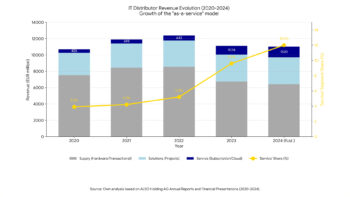Bartosz Martyka, BrandsIT: You have 30 years’ experience in IT, and have been involved in the digitalisation of companies in various sectors for eleven years. Based on this experience and knowledge, tell us, do you see any common denominator when it comes to business problems in moving to the cloud?
Piotr Podlawski, Beyond.pl: Regardless of what type of business you run, this common denominator has always existed. I would call it user environment management. Note that effective management of users and their permissions is very important, whether it is a bank, a manufacturing company or any other type of business.
During the pandemic, this factor has become all the more important. The situation of forced remote working highlighted the importance of managing the user environment in terms of effective data security. To use an example, by properly managing access, we can allow or disallow certain employees to perform specific activities or make resources available, depending on whether they are working in the office or remotely. For example, we may decide that remote employees will not be able to access certain data and the ability to print documents on a home printer for security reasons using the same laptops. These are just simple examples, but they illustrate well the point and importance of user environment management, through which we can gain full control over the company’s resources and the capabilities of the system’s users. This is the basic common denominator that all companies are beginning to recognise.
The second common denominator for all, but also a challenge, is that when migrating to the cloud you should always analyse your infrastructure. In fact, in every company it will be the case that some workloads should be migrated to the cloud and some not necessarily, or at least not in the form they are in at the time of migration. In doing so, it is worth noting that there is no industry where it can be said that migrating everything to the cloud will be a good idea. In every industry, there will be workloads and systems that will be suitable for use in the cloud and those that absolutely should not be migrated, at least not at the time.
And since we’ve probably all grown up with the idea that having data in-house is no protection at all, I would add data security to the list of issues to look at. Unless we come up with the idea of cutting off our internet, right? Then we could call such a solution security, maybe not in the physical sense, but in the logical sense.
So data security is the third common denominator that becomes very important in any industry, because we need to manage the security of distributed data.
And the last thing I would point out as a common part for most companies that migrate to the cloud is the way they approach migration. What I often see (and which by definition is not a good approach) is that some companies treat the cloud as just another server room. It’s a situation where a company comes in, tells you what resources they have and that they want them in the cloud. And that’s it. No re-engineering, just the simplest kind of lift-and-shift migration. And such migrations, if there is no second step behind them, very often end up, openly speaking, in failures. I always say that the cloud is not a virtual server room. It is a platform of modern technologies that we use.
Bartosz Martyka, BrandsIT: You give arguments from the business side, on a general scale. However, behind most implementations and on your side, as a supplier, and on the side of the recipient, i.e. the company, there are IT specialists. What challenges do you see in this respect?
Piotr Podlawski, Beyond.pl: I think that the biggest challenge in this area is the lack of knowledge on the part of companies about the data they have. Of course, IT departments know what servers they have, how the infrastructure is technically built. However, a classic example of what I’m talking about is a situation in which a customer wants to migrate their data to Sharepoint Online, for example. The question then becomes – what data? And only then it turns out that ….. we don’t know. So another question arises – which resources are important and which are not? Often the business within a company does not know whether the data it holds is important. It also often turns out that the owners of that data no longer work for the company. This is what I see as one of the most important challenges of migration in the scope you mentioned, which is the element of inventorying the resources you have and planning. Without that, it’s hard to move on to the next step.
Another key element that I urge everyone to do is the proof of concept and the preparation of so-called landing zones. We have to take into account that by making changes to the physical infrastructure and moving resources to the cloud, we increase the latency of services. The system that customers have had to maintain locally has worked with practically no latency. If we move it to any data centre a few hundred kilometres away, we start operating in a latency range of a few milliseconds. This is why we need to check beforehand how our systems will behave. For 90% of systems, everything will work fine. On the other hand, for quite a few systems, especially those based on thick client solutions, this latency can be deadly for them and then we will have to switch to terminal operation or leave them on-premise.
A common problem we face is also an overly optimistic migration plan. That is, a situation in which a customer’s IT partner comes to us, because we also work with IT providers, and says that he sees no problem in a migration that he has already done many times and that it is a standard ‘out of the box’ migration with him. However, practice shows that every migration is different. Of course, we use our experience for each migration, but an individual migration plan has to be done each time.
Of course, there are also worse situations, such as the enormous time pressure initiated by the customer. When launching a project in October, the assumption of completing the migration at the end of the year because the licence for the servers or for another system is running out, for example, is wishful thinking. Migration obviously needs to be based on a plan that results in an end date. If, on the other hand, the date is imposed in advance, then migration requires a certain degree of caution.
Bartosz Martyka, BrandsIT: Beyond.pl has a large portfolio when it comes to solutions and services. And I wonder, do you have these solutions planned in advance for specific sectors of the economy, for specific customers, or is there a work from scratch and an analysis of a given company, a given case every time?
Piotr Podlawski, Beyond.pl: It is a mixed model, addressing different segments. I don’t think anyone has such fully universal solutions. Admittedly, there are ‘out of the box’ solutions, but buying them often leads to the conclusion that the best system is the one you don’t actually use.
Of course, we have solutions where we can say that they are almost ready for specific industries, e.g. for e-commerce or production. There are also colocation services, and for the financial sector, it could be a private sovereign cloud based on VMware technology or Azure Stack HCI , which is a natural complement to the Azure platform.
However, in each case, an analysis of the customer’s needs is done from the perspective of today and the future. On this basis, we can recommend the best financial or business services. There are also needs that do not require special planning, especially if they only require ‘topping up’ the existing infrastructure.
The customer’s infrastructure works according to a system that was created in some way, and it is up to Beyond.pl, as a professional partner, to fine-tune the migration and choose the best solution that fits the customer’s needs and resources.
Bartosz Martyka, BrandsIT: There are quite a few companies operating in the cloud market. Tell us, what sets you apart?
Piotr Podlawski, Beyond.pl: First of all, what distinguishes us is that we are not just a cloud provider. Our differentiator is that we provide comprehensive customer support for data storage and maintenance – in any model, be it IaaS or hybrid, which is a combination of the customer’s on-premises infrastructure with the cloud and/or colocation.
Additionally, we have a comprehensive service offering, providing customers with end-to-end administrative support.
We are undeniably distinguished by the issue of the highest security standards, as evidenced by the certifications and standards we have obtained. We comply with a number of independent security standards. Data Centre 2 is the only data centre in the EU with the highest level of security confirmed by two independent bodies: ANSI/TIA-942 Rated 4 certification and EN 50600 Class 4 standard.
The second element that definitely sets us apart from the competition is our support for customers in reducing the carbon footprint generated by data. Both Beyond.pl data centres in Poznań are powered by 100% renewable energy.
Going forward, we layer cloud multiplatformity on top of all this. We offer two public clouds from our data centres (VMware and e24cloud) and a Microsoft cloud platform, as well as VMware private cloud environments and a VMware-based sovereign cloud as the first Polish and one of nine VMware partners in Europe. Microsoft’s public cloud offering is complemented by a private part based on Azure Stack HCI.
On top of this, let’s add another layer to our business – connectivity, i.e. how to connect all these clouds most efficiently to each other or additionally to data maintained locally or off-premise.
Most cloud partners do not base the foundation of their business on their own data centres and do not develop a diverse cloud portfolio in parallel, The fact that we are an end to end provider is our competitive advantage.
Bartosz Martyka, BrandsIT: Can a small company use your services or are you only interested in large companies?
Piotr Podlawski, Beyond.pl: Smaller companies are also Beyond.pl customers. They very often use our proprietary e24cloud, where many companies create e-commerce platforms. Although in the case of a really small company, one should consider whether this is the best path for them to create their own online shop. A better option might be our partner IdoSell who, using Beyond.co.uk since 2013, provides the same online shops as a PaaS service.
However, I think that the size of a company as defined in the traditional way does not matter much when it comes to the cloud, but rather what services the company wants and pays for. If a company is interested in a virtual machine with a website, it can choose any provider of such a service. In the case of small-scale use, it is rather difficult to see spectacular benefits. On the other hand, the more complex the infrastructure a company needs, the more important multi-platform becomes. It is this factor that tends to make medium and large companies choose us.
After 11 years in the industry, I have completely re-evaluated my approach to viewing companies through the prism of their size. When I was still working on the hardware side the world was simple. Back then, a company that had 1,000 ‘PCs’ was called big. And now it looks different. Let’s compare two modern businesses – on one side we have, for example, a factory that has 1,000 employees who rarely use IT systems, and on the other side there is an online shop with 20 employees that performs millions of transactions and generates multi-million dollar revenues. And let’s ask ourselves which of these companies is small and which is big. From the point of view of the cloud, this online shop is the big company. Therefore, these notions of large, small or medium-sized company no longer quite apply when it comes to cloud solutions.
Bartosz Martyka, BrandsIT: You mentioned the issue of security earlier. Let’s go back to this topic. What does it look like for you in terms of data, but also infrastructure maintenance?
Piotr Podlawski, Beyond.pl: As I mentioned earlier, as Beyond.pl we meet very high security standards confirmed by two independent bodies: ANSI/TIA-942 at the highest Rated 4 level and the EN 50600 Class 4 standard, which are the two most important standards in our industry. What differentiates the ANSI/TIA-942 standard that the Data Centre 2 facility has had since 2016 from other data centre facility standards is that with ANSI/TIA we are recertified every 3 years and the standard is not declarative.
In a Rated 4 facility, all infrastructure elements are redundant, i.e. redundant. Meeting the standard requires, among other things, that the infrastructure has different paths and power sources, the data centre facility is adequately physically secured, and the telecommunications links must be multiplexed. In our case, we are talking about a much larger number of links, as we work with more than 25 operators. Rated 4 according to ANSI/TIA-942 confirms an uptime of 99.9995%.
I once took part in a very interesting debate where we came to the conclusion that there is no such thing as security solutions, and security is really the mindset of an organisation. Everything else is about the tools that make it possible to realise the company’s objectives and approach to it. In various media outlets(I have noticed this with you too), companies focus on security in the context of data or the concept of Zero Trust Security. But it’s important to remember that security starts at the power cable in the switchgear – from the power supply, right through Zero Trust Security, the application layer, all the way to the wifi network we connect to at home. That is the whole cross-section of security.
And in terms of how we build security already at the architecture level – many of our customers use active-active solutions, thanks to the fact that we have two data centres 11km apart connected by a private fibre ring. At Beyond.pl, we create distributed clusters that operate in two independent facilities and this is a good solution for those customers who want the highest level of security. The use of such an architecture allows us to provide a service SLA of up to 99.9999%.
Bartosz Martyka, BrandsIT: We have three models when it comes to the cloud, namely public, private and hybrid cloud. How do you support these models?
Piotr Podlawski, Beyond.pl: At Beyond.pl we support each of these models. Starting with the public cloud, we have three platforms – two in our data centre i.e. VMware and e24cloud and Microsoft platforms (Azure, Microsoft 365). If we talk about private cloud, we offer a VMware private cloud and a sovereign cloud based on VMware solutions. The hybrid cloud, on the other hand, is the Azure Stack HCI platform.
Both the Beyond.co.uk team and I personally believe that the world is moving towards hybridity. There will no longer be a public-only or private-only cloud option. This approach makes Beyond.pl necessarily support all cloud models and we offer customers a combination of these solutions. Particularly as the transition to a hybrid cloud model, or as innimulticloudamult-icloud prefers, is more difficult than to a purely public or purely private cloud.
Bartosz Martyka, BrandsIT: I asked you earlier about the size of the companies you serve. You did a great job of explaining how you define small and large businesses. Let’s assume a situation where an IT specialist from some company comes to Beyond.co.uk to talk about an implementation. What skills do they need to have on the client side? Do you have any requirements in this regard?
Piotr Podlawski, Beyond.pl: It all defines the project. You just said an IT specialist is coming in, which means there is an administrator in that company who has a general overview and needs support in certain areas. Perhaps that administrator is not a great project manager, in which case we, as a partner, provide the project manager. The IT specialist you mentioned perhaps administers databases on a daily basis, but is not exactly an expert in this area. Then we, as Beyond.pl, try to provide the missing competences. On the other hand, in medium and large companies, IT departments function quite vigorously. It is up to us to take the burden of migration away from the internal IT department, because it should be in charge of supporting the business and we, as a Managed Service provider, are able to provide the company with a solution. Often it doesn’t make sense for the IT administrator to take over the database administration if it’s a company where there are two administrators and only one is familiar with it. It may be better for us to take over the process of database administration and care, and for the in-house administrators at the client to regain time to deal with systems development within the organisation.
In my opinion, it is absolutely wrong to think of the cloud as a way to reduce staffing in the IT department. That is not why we go to the cloud. The move to the cloud is so that people working in the IT department can finally get on with building the technological backbone of the company, rather than putting out fires, as is the case in most organisations.
Bartosz Martyka, BrandsIT: Sometimes I get the impression that it is the IT industry that is misleading the business by encouraging them to move to the cloud, presenting it as a remedy for the company’s IT management problems. Yet this is not the truth.
Piotr Podlawski, Beyond.pl: Of course it is not true. It is very important to look at these relationships with the customer in the long term. That is why I do not agree with the notion of selling the cloud. I sometimes hear someone say “I sold Office 365, I sold cloud”. You’ve sold and then what? In fact, that customer will only be happy if we make sure that they actually have the benefit of that service, which is de facto just a tool to achieve their goals.
Unfortunately, there are indeed areas of the IT industry where this kind of typical trading of cloud services is taking place, but I see an improvement and it is not happening as often as it used to.
It is also worth remembering that when migrating to the cloud, we have a lot of other tasks related to automation, among other things, and you also have to be prepared for that. If we use a ‘lift and shift’ approach, the scope of work does not really change when we move to the cloud. The only relief for the customer’s IT department is the transfer of the duty to physically maintain the machines to the cloud provider, but this task is not very time-consuming. Of course, the working time to maintain the infrastructure will decrease.
But once again, I warn that this is not why you go to the cloud to have less work. As long as automation of systems, for example, is not implemented, it will have to be done manually, whether the infrastructure is in the cloud or not.
Bartosz Martyka, BrandsIT: Coming already to the end of our conversation, I’m curious what trends do you see in terms of the future of the industry? How do you at Beyond.co.uk plan to respond to both these trends and the challenges that are around the corner?
Piotr Podlawski, Beyond.pl: I think we are going to see an outsourcing trend. Some studies say that 95% of companies will abandon their own infrastructure in the company server room by 2027. Personally, I don’t think these are such radical numbers and I don’t believe it will be such a high percentage of companies. But such a trend will certainly be there.
The next trend, of course, will be the trend of migration to the public cloud, which will continue to grow. And our job will continue to be to support companies in migrating to the best option and building a hybrid infrastructure.
But on the other hand, with the growing trend of migration to the public cloud, I think the number of failures in this area will also increase directly proportionally. I recently read an article about someone lamenting that they had migrated resources from their own physical servers to the public cloud 1:1 and then moved them back to those machines because it was a much cheaper solution for them. And it raised this question with me: if you had workloads based on physical machines, why were you even going to the public cloud without a Solution Assessment process? So, in light of these kinds of migration failures, our job would be to propose optimal solutions and transfer knowledge to the customer.
Today, as we are having this conversation, is the day of the official announcement of the Microsoft region in Poland. As a Microsoft partner that supports migrations to Azure and helps customers maintain Microsoft’s public cloud, we are very excited about the launch of the local region. While the mere fact of launching a local region obviously changes data residency and latency to cloud services, it does not, after all, solve the problem of having a ‘cloud ready’ strategy in companies.
Many companies, influenced by such information, will start thinking about migration, but don’t make a quick and independent move without a plan – then you will avoid costly experiments. In order to plan a move to the cloud, it is worth at least consulting experts, and this is something we will always support our customers in.
The last thing I want to mention, which I think is a very important trend, is investment in competences, which we are strongly expanding at Beyond.pl at the moment. I think that in the next few years we will face a shortage of IT competences in companies. This is, of course, due to the shortage of cloud professionals in the market who have broad experience.
Bartosz Martyka, BrandsIT: Thank you very much for the interview.












